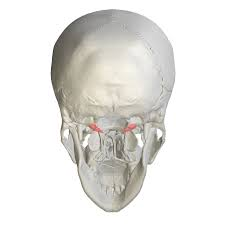
The number of occipital condyles in man is/are:
A. One
B. Two
C. Three
D. Four
Answer
493.5k+ views
1 likes
Hint: Occipital condyles are the protrusions on the occipital bone of the skull. A joint is formed between the first cervical vertebra and the protrusion on the occipital bone of the skull which helps the head to move relative to the neck is an occipital condyle.
Complete answer:
1. They are the bony protrusions on the occipital bone of the skull. It forms a joint (atlanto occipital joint) with the first cervical vertebra, enabling the head to move relative to the neck is an occipital condyle.
2. Humans have two occipital condyles. They are large rounded kidney-shaped projections of the occipital bone, that are located contralateral to the foramen magnum (opening for the spinal cord) and that articulates with the superior facets of the atlas cervical vertebra (1st cervical vertebra).

Additional Information:
1. Occipital condyle syndrome (OCS) is a rare syndrome characterized by severe, unilateral (on one side), occipital headache and ipsilateral (same side as that of the anomaly), and 12th nerve palsy (hypoglossal nerve cause weakness or wasting/ atrophy of the tongue on the affected side).
2. Tumors are the common cause of OCS. Inflammatory lesions causing OCS is rare
OCS is the only clinical manifestation in young people suffering from craniovertebral tuberculosis.
So, the correct answer is “Option A Two”.
Note: Isolated condyle fracture is a type of craniocervical injury. Symptoms of an isolated occipital condyle fracture are similar to those of other craniocervical injuries, including high cervical pain, reduced range of motion, unusual head/ neck posture, prevertebral swelling, and lower cranial nerve (IX, X, XI, XII) deficits, tetraparesis (also known as tetraplegia and quadriplegia, it is the paralysis caused by illness or injury that results in the partial or total loss of use of all four limbs and torso of the body) or abnormal breathing.
Complete answer:
1. They are the bony protrusions on the occipital bone of the skull. It forms a joint (atlanto occipital joint) with the first cervical vertebra, enabling the head to move relative to the neck is an occipital condyle.
2. Humans have two occipital condyles. They are large rounded kidney-shaped projections of the occipital bone, that are located contralateral to the foramen magnum (opening for the spinal cord) and that articulates with the superior facets of the atlas cervical vertebra (1st cervical vertebra).

Additional Information:
1. Occipital condyle syndrome (OCS) is a rare syndrome characterized by severe, unilateral (on one side), occipital headache and ipsilateral (same side as that of the anomaly), and 12th nerve palsy (hypoglossal nerve cause weakness or wasting/ atrophy of the tongue on the affected side).
2. Tumors are the common cause of OCS. Inflammatory lesions causing OCS is rare
OCS is the only clinical manifestation in young people suffering from craniovertebral tuberculosis.
So, the correct answer is “Option A Two”.
Note: Isolated condyle fracture is a type of craniocervical injury. Symptoms of an isolated occipital condyle fracture are similar to those of other craniocervical injuries, including high cervical pain, reduced range of motion, unusual head/ neck posture, prevertebral swelling, and lower cranial nerve (IX, X, XI, XII) deficits, tetraparesis (also known as tetraplegia and quadriplegia, it is the paralysis caused by illness or injury that results in the partial or total loss of use of all four limbs and torso of the body) or abnormal breathing.
Latest Vedantu courses for you
Grade 11 Science PCM | CBSE | SCHOOL | English
CBSE (2025-26)
School Full course for CBSE students
₹41,848 per year
Recently Updated Pages
Master Class 11 Economics: Engaging Questions & Answers for Success

Master Class 11 Business Studies: Engaging Questions & Answers for Success

Master Class 11 Accountancy: Engaging Questions & Answers for Success

Master Class 11 English: Engaging Questions & Answers for Success

Master Class 11 Computer Science: Engaging Questions & Answers for Success

Master Class 11 Maths: Engaging Questions & Answers for Success

Trending doubts
State and prove Bernoullis theorem class 11 physics CBSE

1 ton equals to A 100 kg B 1000 kg C 10 kg D 10000 class 11 physics CBSE

State the laws of reflection of light

One Metric ton is equal to kg A 10000 B 1000 C 100 class 11 physics CBSE

1 Quintal is equal to a 110 kg b 10 kg c 100kg d 1000 class 11 physics CBSE

Difference Between Prokaryotic Cells and Eukaryotic Cells




